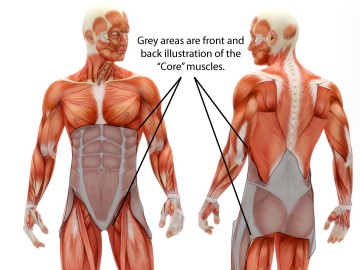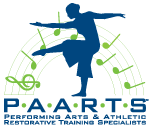Injury Prevention Tips for Performing Artists and Athletes
“Your inner strength is your outer foundation.” – Alan Rufus
We are all familiar with the term “core strength”, but what does that mean exactly? Some may think that it is a toned abdomen, the classic “Six Pack” abdominals. However, unlike than the superficial muscles that create the toned looking tummy, the “core” is actually an assortment of small and large muscles of the trunk that work in concert to transmit forces through the body as well as to protect the spine. You can think of the core muscles as muscles that function like a corset around the trunk, with further connections into the arm and leg muscles. These links into the extremities are what allow for powerful throws, jumps, kicks, leaps etc.
 There are Two Types of “Core” Muscles
There are Two Types of “Core” Muscles
The “core” is made up of “local” and “global” muscles. More plainly, local muscles are the interior, smaller muscles. They are suited for supporting posture and spinal stability. At a basic level, the local muscles include: transverse abdominis, multifidus, inner fibers of the quadratus lumborum, diaphragm, and the muscle of the pelvic floor. The second type of musculature are the global muscles; they are larger muscles, suited for moving joints and creating power. The basic global muscles include: rectus abdominus, external obliques, internal obliques, outer fiber of the quadratus lumborum, anterior fibers of the psoas, and latissimus dorsi – as well as the muscles that extend into the extremities such as the gluteals, the quadriceps and hamstrings.
The “Core” and Injuries
In recent years, significant emphasis has been placed on core stability in both rehabilitation and performance enhancement settings. Core control, or lack thereof, during athletic and vocational activities has been linked to an number of acute and chronic injuries including low back pain, hip, knee, ankle and shoulder injuries. For example, hip muscle activation affects the ability of the quadriceps and hamstring muscle groups to generate and resist forces experienced by the lower extremity during jumping activity. Lack of coordinated muscle action of these groups has a direct relationship to acute and chronic injuries including: anterior cruciate ligament rupture, patellofemoral pain syndrome, and acute lateral ankle sprain as observed in dancers and athletes.
For musicians, lack of core stability and support relates to postural deficiencies and thereby repetitive stress injury such as neck, upper and low back pain, thoracic outlet syndrome, and arm pain and weakness. Hypertonicity (rigidness) in the neck and upper back muscles suggests that the musician may be substituting use of the extremity muscles to support their posture over use of the correct “core”/ trunk musculature.
For actors and singers, core stability relates to posture and thereby breath support and control needed for appropriate vocalization. Additionally, the physical demands of acting can range from pedestrian movements to aerial art and even high level stunts – skills which can be positively affected by increased core stability.
Enhancing your performance
In addition to the known benefits in rehabilitation and injury prevention, core stability training is also used to augment performance. Enhanced core stability provides a foundation for greater force production and force transfer from the trunk into the extremities, and thereby maximal power and support. Core stability training can result in enhanced jump takeoff, height and landing performance as well as improved posture for instrument support and vocalization.
Physiologically, the positive impact that core stability training provides in rehabilitation, injury prevention and peak performance is explained by the effect that it has on increasing the sensitivity of the muscle, resulting in a greater state of readiness for the loading of joints. Core stabilization involves progressive strengthening of isolated muscles with advancement to co-activation techniques in a variety of postures, and finally with the use of multi-joint exercises that incorporate one or more large muscle groups or areas with the synergistic assistance of one or more, smaller muscle groups or areas.
A comprehensive assessment to determine the athlete or performing artists’ current level of core stability should be performed, followed by a core stability program design that addresses the individuals’ areas of deficiency.
If you are experiencing an injury that may be related to poor core stability, or if would like more focused assistance in your performance enhancement journey as far as injury prevention, improving power, jumping and/or throwing skills , we offer a variety of services for athletes and performing artists at PAARTS Wellness Studio. Please contact us for more informationor to schedule an appointment.


